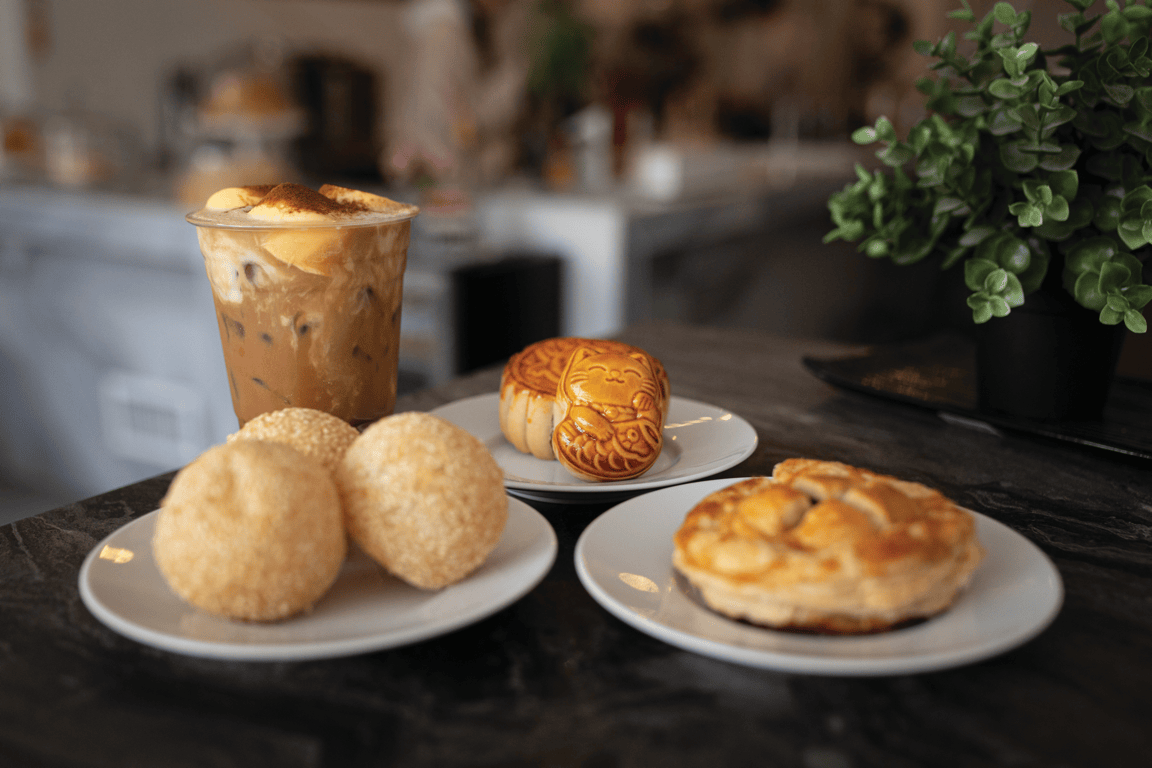
Vietnamese Café Vibes
Coffees, snacks and sandwiches translate into new opportunities
Vietnamese Café Vibes
Coffees, snacks and sandwiches translate into new opportunities
By Katie Ayoub
February 7, 2024
By Katie Ayoub
February 7, 2024
Vietnam’s dynamic café culture is creating an enthusiastic following, with concepts expanding throughout the U.S., extending reach and inspiring menu adaptations across foodservice. Cafés making impact include Seattle’s Hello Em Viêt Coffee & Roastery, featuring familiar-yet-adventurous builds like the Cà Phê Chuoi, a Vietnamese coffee drink with caramelized banana, egg cloud, salted peanuts, coconut and banana chips, served hot or cold. Its food menu is just as enticing with offerings like the Pork Floss and Cured Egg “Fluff” Bread pastry item and a pressed sandwich called Breakfast Croissant, starring a fried shallot omelette, bone marrow pâté and “Viet mayo.” Càphê Roasters in Philadelphia menus playful, creative beverages like its Salted Brûlée Cà Phê, a Vietnamese espresso drink with condensed milk and a torched topping of salted cream cold foam and brown sugar.
Tí Café in Denver showcases a world of textural possibility in coffee and tea drinks. Its Café Trung is the concept’s version of the classic egg custard coffee, a rich, indulgent, fun drink that’s an early breakout star, helping pave the way for further exploration. The Flan-Topped Vietnamese Iced Coffee uses quivering chunks of flan as a sweet, soft garnish. “While curating our menu during its early stages, our biggest motivator was crafting drinks that could spotlight and introduce Vietnamese ingredients and desserts by combining elements in a unique way to create complex, complementary flavors,” says Shominic Nguyen, one of three sisters behind the shop. “With flan being a staple treat in traditional Vietnamese cuisine, we thought the sweet and bouncy, pudding-like texture would pair perfectly with the strong, bold flavors of cà phê sua dá. Dusted with cocoa powder to enhance the chocolatey undertones of our beans, the flan topping and the cà phê sua dá work hand-in-hand to create one unique yet nostalgic drink, a modern take built from traditional Vietnamese ingredients.”
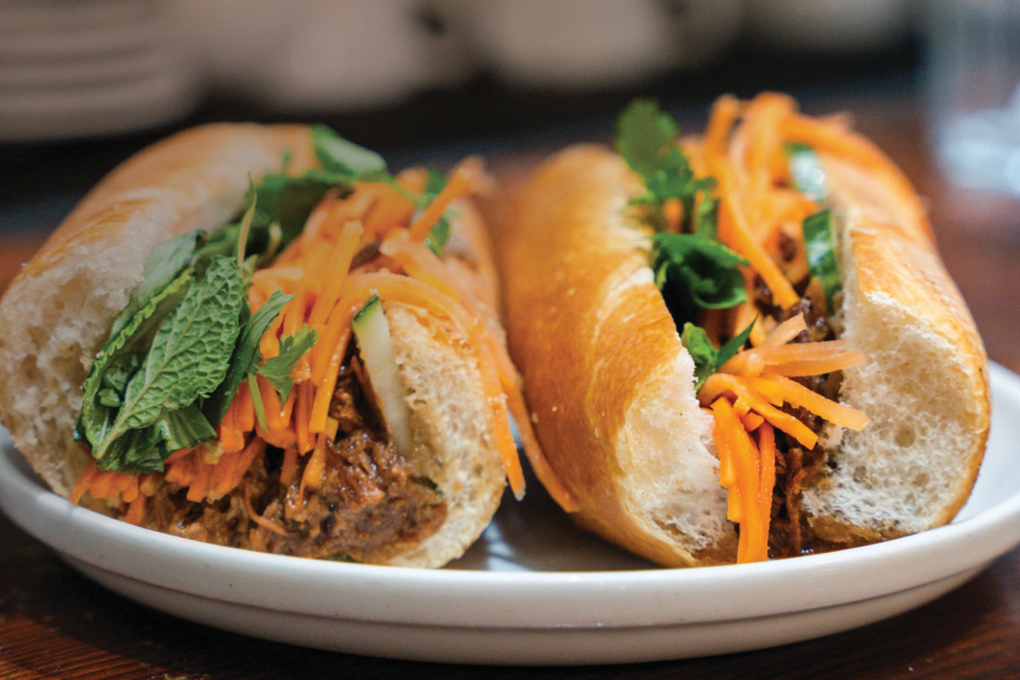 Photo Credit: The Breakfast Den
Photo Credit: The Breakfast Den Philadelphia’s Breakfast Den menus a Banh Mi Pulled Pork with housemade pickles, cucumbers, jalapeño, herbs, aïoli and eggplant pâté on a baguette.
Vietnamese cafés are proliferating thanks to a warm reception by U.S. consumers. Their success signals an evolution in American coffee culture. “Our coffee culture has matured enough that consumers are no longer satisfied with the European-focused style that has been dominant in the U.S. for many years,” says Maeve Webster, president of Menu Matters consultancy. “Both consumers and operators are looking for the next thing. Where do we go from here? We’ve played out pumpkin spice and iterations like that. Vietnamese coffee culture offers a new world of possibilities.”
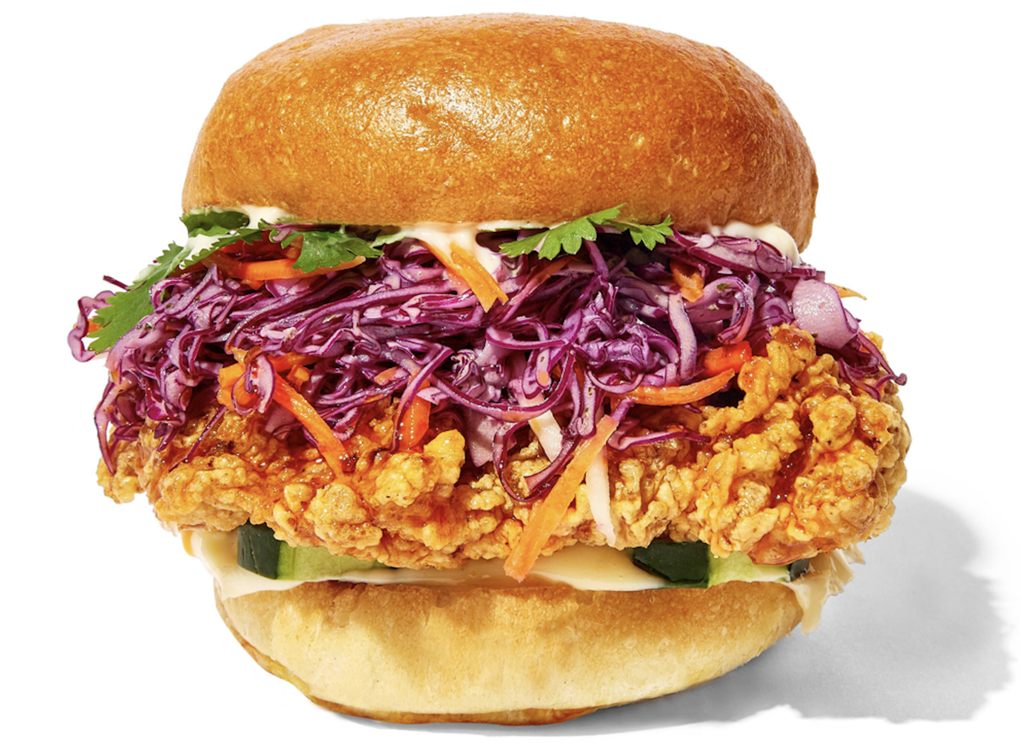 Photo Credit: Bun Mee
Photo Credit: Bun Mee San Francisco’s Bun Mee layers Vietnamese ingredients, like lemongrass-chile crisp, cucumber, pickled carrot and daikon and cilantro, on its Crispy Fried Chicken sandwich.
Although beverage opportunity leads the charge here, the food side of Vietnamese cafés also hits a number of modern flavor preferences. “Breakfast is solidly breaking out of the rut it’s been stuck in for the last couple of decades,” says Webster. “What’s interesting about Vietnamese cafés is that Vietnamese cuisine is already naturally intertwined with French cuisine because of its history. This lends itself to a lot of very familiar things happening with flavor builds—even if there are incredibly unfamiliar elements.” That adventure tied with the familiar is, as we know, the foundation of modern menu innovation.
Beverage Bonanza
A firehose of beverage ideas bursts from Vietnamese coffee culture. “Vietnamese beverages are having a moment,” says Nikki Freihofer, strategy director, The Culinary Edge. “A huge part of its growing success dovetails off the immense popularity of boba and bubble tea. Younger consumers love to purchase beverages more than any other generation does. It’s that affordable luxury, the little splurge, that fits nicely into their lifestyles. And their love of textures within a beverage is huge. Boba and popping bubbles were just the tip of the iceberg.” With Vietnamese cafés, she points out, textural elements are king, from aloe and lychee bubbles to egg whips. “The trend is telling us that consumers want more complex drinks that are not just liquid,” says Freihofer. “They want textures and whips and foams and bubbles and jellies, and Vietnamese coffee culture offers all of that.”
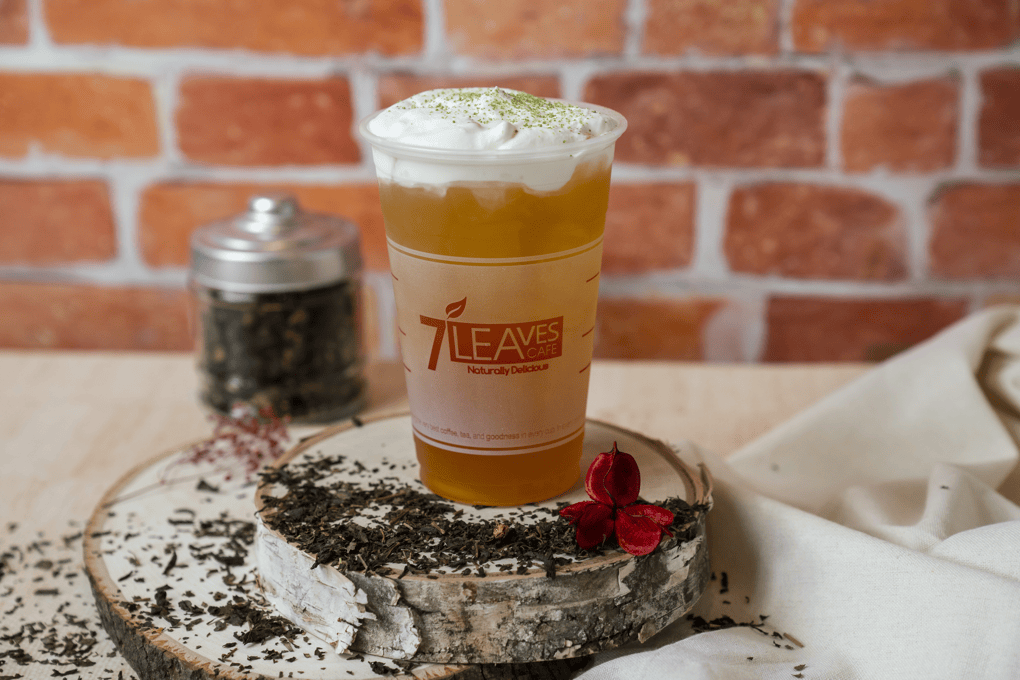 Photo Credit: 7 Leaves Café
Photo Credit: 7 Leaves Café 7 Leaves Café, based in Garden Grove, Calif., tops the Sea Cream Tea Jasmine with a housemade sea salt whipped cream.
To understand its appeal, it’s important to start with the coffee itself. “Vietnamese coffee stands out for its unique, robust flavor, achieved through the use of strong, dark-roasted coffee beans paired with sweetened condensed milk,” says Jack Zhong, brand manager at 7 Leaves Café, based in Garden Grove, Calif. “This distinctive taste sets it apart from the milder flavors typically found in American coffee. The traditional brewing technique, involving a drip filter called a phin, contributes to a slow-drip process, resulting in a more concentrated, flavorful brew. The addition of sweetened condensed milk is a signature element, introducing a creamy, sweet component that contrasts with the black coffee, appealing to those who enjoy a blend of strong coffee and sweetness.”
Cake Bar, a dessert and bubble tea café in Syracuse, N.Y., serves a few fun flights, both of its milk teas and its coffee drinks. The Taro Espresso stands out with a nutty, sweet flavor, adding depth and differentiation. Bun Mee, based in San Francisco, showcases the opportunity by tethering exotic flavor touches to approachable builds. Its Vanilla Lychee Tea features lychee-flavored tea with a rich, soft whip and lime. Its Vietnamese Cream Cloud represents one of the rising celebrities of this coffee culture. Here, it sees a combination of Vietnamese coffee, soft whip and a sprinkle of five-spice powder. The Culinary Edge helped create new menu items for the fast casual, working with owner Denise Tran. “The new generation of coffee drinkers won’t be satisfied with half and half or creamer,” says Freihofer. “That’s ‘Boomer’ coffee. Each distinct element should have its own identity, from a cinnamon whipped foam to layered taro.”
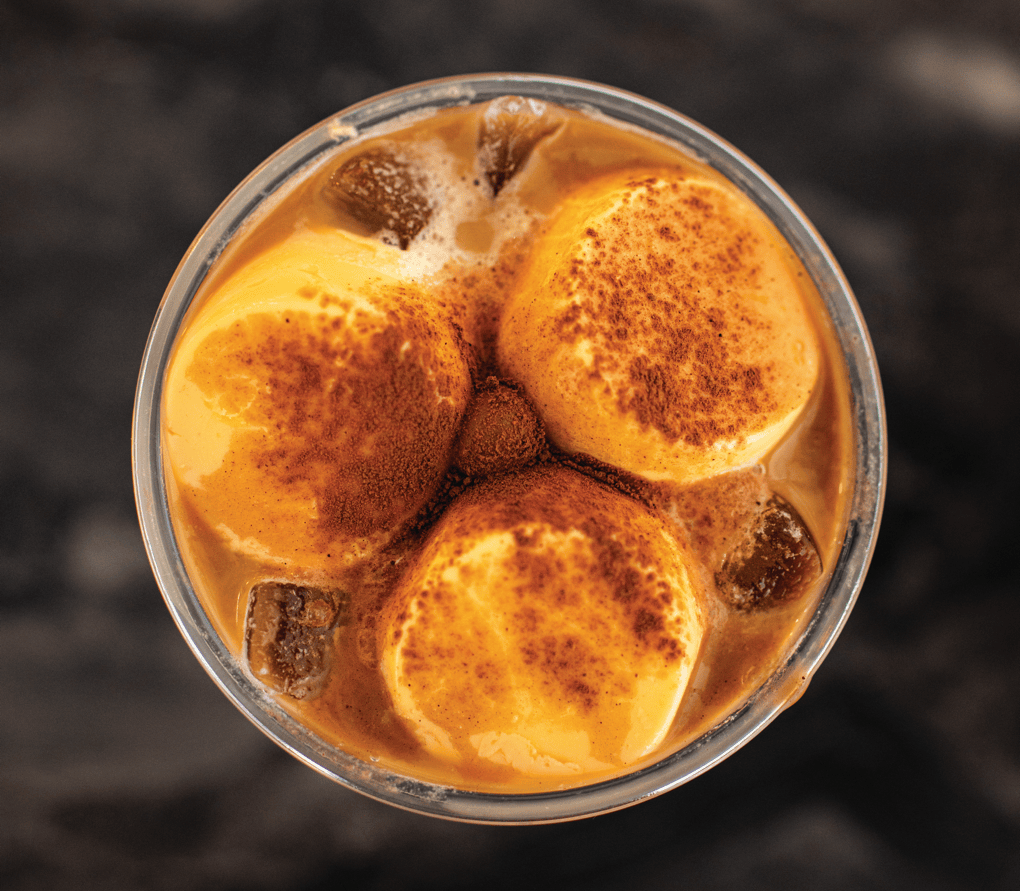 Photo Credit: George Lomas Photography on Instagram @glomasphotos
Photo Credit: George Lomas Photography on Instagram @glomasphotos Flan is a common treat in Vietnamese cuisine, making it a relevant and fun inclusion in this iced cà phê sua dá on the menu at Tí Café in Denver.
Food, Glorious Food
Today, breakfast-themed foods are hugely popular with consumers. Energizing the category with Vietnamese-inspired builds is a smart strategy. “The trend in Vietnamese café culture feels so perfectly timed,” says Mindy Armstrong, VP of menu innovation at Ascent Hospitality Management. “Banh mi was quickly accepted into the sandwich world here, with its craveable build inspiring so many creative translations. Right behind that acceptance and embrace of banh mi is Vietnamese café culture, coming in strong as an experiential trend.” Part of that is discovering Vietnamese flavors in the form of breakfast sandwiches, pastries, bowls and more. “The trend reminds me of Cuban coffee culture, where the Cubano and coffee walk hand in hand,” she says. “The combination felt approachable to American consumers. Now, you’ve got a different version of it popping up, with Vietnamese coffee drinks and the famous banh mi.”
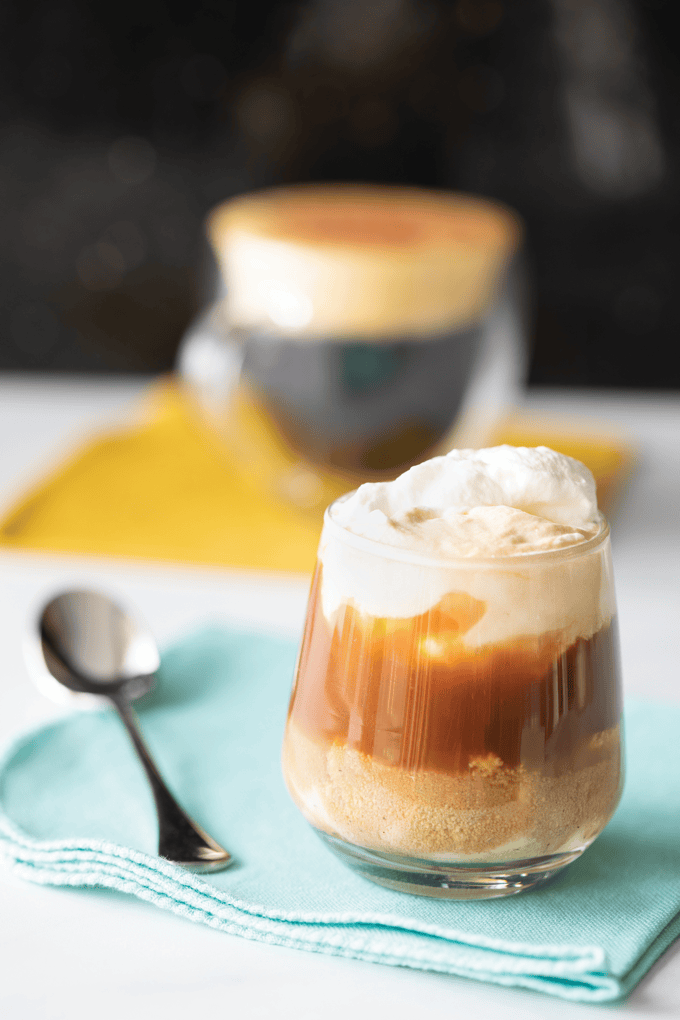 Photo Credit: American Egg Board
Photo Credit: American Egg Board With its eye on emerging trends, the American Egg Board developed this Vietnamese Cream Coffee, featuring a foam made with powdered sugar, liquid egg yolk, condensed milk and heavy cream.
There’s fertile ground to explore in both sweet and savory, and still so much runway with the banh mi. Breakfast and snack versions demonstrate creative menu potential. The Breakfast Den, a Philadelphia café that serves American-Vietnamese comfort food, menus the Banh Mi Op La, featuring two crispy sunny-side-up eggs, bacon, sausage patties, house pickles, herbs, eggplant pâté and aïoli on a baguette. At Vietfive, a Vietnamese coffee shop in Chicago, the banh mi takes shape as the Banh Patê Sô, a Viet-French puff pastry made with five-spice tofu and veggie or ground beef. Philadelphia’s Càphê Roasters morphs the banh mi into a fried chicken sandwich offering. Its Khang’s Special Banh Mi features gochu-glazed fried chicken, fried eggs, pork pâté and housemade mayo.
On the sweet-bites side—an important part of any café culture—Vietnamese cafés do not disappoint. Banh Xeo Boys in Stanton, Calif., plays up iconic coffee flavors with its Vietnamese Coffee Churros, golden brown churros dusted in cinnamon sugar and served with a Vietnamese Coffee Dip. From sweet to savory and from food to beverage, Vietnamese-style cafés promise fertile ground for new menu ideas.
Vietnam’s dynamic café culture is creating an enthusiastic following, with concepts expanding throughout the U.S., extending reach and inspiring menu adaptations across foodservice. Cafés making impact include Seattle’s Hello Em Viêt Coffee & Roastery, featuring familiar-yet-adventurous builds like the Cà Phê Chuoi, a Vietnamese coffee drink with caramelized banana, egg cloud, salted peanuts, coconut and banana chips, served hot or cold. Its food menu is just as enticing with offerings like the Pork Floss and Cured Egg “Fluff” Bread pastry item and a pressed sandwich called Breakfast Croissant, starring a fried shallot omelette, bone marrow pâté and “Viet mayo.” Càphê Roasters in Philadelphia menus playful, creative beverages like its Salted Brûlée Cà Phê, a Vietnamese espresso drink with condensed milk and a torched topping of salted cream cold foam and brown sugar.
Tí Café in Denver showcases a world of textural possibility in coffee and tea drinks. Its Café Trung is the concept’s version of the classic egg custard coffee, a rich, indulgent, fun drink that’s an early breakout star, helping pave the way for further exploration. The Flan-Topped Vietnamese Iced Coffee uses quivering chunks of flan as a sweet, soft garnish. “While curating our menu during its early stages, our biggest motivator was crafting drinks that could spotlight and introduce Vietnamese ingredients and desserts by combining elements in a unique way to create complex, complementary flavors,” says Shominic Nguyen, one of three sisters behind the shop. “With flan being a staple treat in traditional Vietnamese cuisine, we thought the sweet and bouncy, pudding-like texture would pair perfectly with the strong, bold flavors of cà phê sua dá. Dusted with cocoa powder to enhance the chocolatey undertones of our beans, the flan topping and the cà phê sua dá work hand-in-hand to create one unique yet nostalgic drink, a modern take built from traditional Vietnamese ingredients.”
 Photo Credit: The Breakfast Den
Photo Credit: The Breakfast Den Philadelphia’s Breakfast Den menus a Banh Mi Pulled Pork with housemade pickles, cucumbers, jalapeño, herbs, aïoli and eggplant pâté on a baguette.
Vietnamese cafés are proliferating thanks to a warm reception by U.S. consumers. Their success signals an evolution in American coffee culture. “Our coffee culture has matured enough that consumers are no longer satisfied with the European-focused style that has been dominant in the U.S. for many years,” says Maeve Webster, president of Menu Matters consultancy. “Both consumers and operators are looking for the next thing. Where do we go from here? We’ve played out pumpkin spice and iterations like that. Vietnamese coffee culture offers a new world of possibilities.”
 Photo Credit: Bun Mee
Photo Credit: Bun Mee San Francisco’s Bun Mee layers Vietnamese ingredients, like lemongrass-chile crisp, cucumber, pickled carrot and daikon and cilantro, on its Crispy Fried Chicken sandwich.
Although beverage opportunity leads the charge here, the food side of Vietnamese cafés also hits a number of modern flavor preferences. “Breakfast is solidly breaking out of the rut it’s been stuck in for the last couple of decades,” says Webster. “What’s interesting about Vietnamese cafés is that Vietnamese cuisine is already naturally intertwined with French cuisine because of its history. This lends itself to a lot of very familiar things happening with flavor builds—even if there are incredibly unfamiliar elements.” That adventure tied with the familiar is, as we know, the foundation of modern menu innovation.
Beverage Bonanza
A firehose of beverage ideas bursts from Vietnamese coffee culture. “Vietnamese beverages are having a moment,” says Nikki Freihofer, strategy director, The Culinary Edge. “A huge part of its growing success dovetails off the immense popularity of boba and bubble tea. Younger consumers love to purchase beverages more than any other generation does. It’s that affordable luxury, the little splurge, that fits nicely into their lifestyles. And their love of textures within a beverage is huge. Boba and popping bubbles were just the tip of the iceberg.” With Vietnamese cafés, she points out, textural elements are king, from aloe and lychee bubbles to egg whips. “The trend is telling us that consumers want more complex drinks that are not just liquid,” says Freihofer. “They want textures and whips and foams and bubbles and jellies, and Vietnamese coffee culture offers all of that.”
 Photo Credit: 7 Leaves Café
Photo Credit: 7 Leaves Café 7 Leaves Café, based in Garden Grove, Calif., tops the Sea Cream Tea Jasmine with a housemade sea salt whipped cream.
To understand its appeal, it’s important to start with the coffee itself. “Vietnamese coffee stands out for its unique, robust flavor, achieved through the use of strong, dark-roasted coffee beans paired with sweetened condensed milk,” says Jack Zhong, brand manager at 7 Leaves Café, based in Garden Grove, Calif. “This distinctive taste sets it apart from the milder flavors typically found in American coffee. The traditional brewing technique, involving a drip filter called a phin, contributes to a slow-drip process, resulting in a more concentrated, flavorful brew. The addition of sweetened condensed milk is a signature element, introducing a creamy, sweet component that contrasts with the black coffee, appealing to those who enjoy a blend of strong coffee and sweetness.”
Cake Bar, a dessert and bubble tea café in Syracuse, N.Y., serves a few fun flights, both of its milk teas and its coffee drinks. The Taro Espresso stands out with a nutty, sweet flavor, adding depth and differentiation. Bun Mee, based in San Francisco, showcases the opportunity by tethering exotic flavor touches to approachable builds. Its Vanilla Lychee Tea features lychee-flavored tea with a rich, soft whip and lime. Its Vietnamese Cream Cloud represents one of the rising celebrities of this coffee culture. Here, it sees a combination of Vietnamese coffee, soft whip and a sprinkle of five-spice powder. The Culinary Edge helped create new menu items for the fast casual, working with owner Denise Tran. “The new generation of coffee drinkers won’t be satisfied with half and half or creamer,” says Freihofer. “That’s ‘Boomer’ coffee. Each distinct element should have its own identity, from a cinnamon whipped foam to layered taro.”
 Photo Credit: George Lomas Photography on Instagram @glomasphotos
Photo Credit: George Lomas Photography on Instagram @glomasphotos Flan is a common treat in Vietnamese cuisine, making it a relevant and fun inclusion in this iced cà phê sua dá on the menu at Tí Café in Denver.
Food, Glorious Food
Today, breakfast-themed foods are hugely popular with consumers. Energizing the category with Vietnamese-inspired builds is a smart strategy. “The trend in Vietnamese café culture feels so perfectly timed,” says Mindy Armstrong, VP of menu innovation at Ascent Hospitality Management. “Banh mi was quickly accepted into the sandwich world here, with its craveable build inspiring so many creative translations. Right behind that acceptance and embrace of banh mi is Vietnamese café culture, coming in strong as an experiential trend.” Part of that is discovering Vietnamese flavors in the form of breakfast sandwiches, pastries, bowls and more. “The trend reminds me of Cuban coffee culture, where the Cubano and coffee walk hand in hand,” she says. “The combination felt approachable to American consumers. Now, you’ve got a different version of it popping up, with Vietnamese coffee drinks and the famous banh mi.”
 Photo Credit: American Egg Board
Photo Credit: American Egg Board With its eye on emerging trends, the American Egg Board developed this Vietnamese Cream Coffee, featuring a foam made with powdered sugar, liquid egg yolk, condensed milk and heavy cream.
There’s fertile ground to explore in both sweet and savory, and still so much runway with the banh mi. Breakfast and snack versions demonstrate creative menu potential. The Breakfast Den, a Philadelphia café that serves American-Vietnamese comfort food, menus the Banh Mi Op La, featuring two crispy sunny-side-up eggs, bacon, sausage patties, house pickles, herbs, eggplant pâté and aïoli on a baguette. At Vietfive, a Vietnamese coffee shop in Chicago, the banh mi takes shape as the Banh Patê Sô, a Viet-French puff pastry made with five-spice tofu and veggie or ground beef. Philadelphia’s Càphê Roasters morphs the banh mi into a fried chicken sandwich offering. Its Khang’s Special Banh Mi features gochu-glazed fried chicken, fried eggs, pork pâté and housemade mayo.
On the sweet-bites side—an important part of any café culture—Vietnamese cafés do not disappoint. Banh Xeo Boys in Stanton, Calif., plays up iconic coffee flavors with its Vietnamese Coffee Churros, golden brown churros dusted in cinnamon sugar and served with a Vietnamese Coffee Dip. From sweet to savory and from food to beverage, Vietnamese-style cafés promise fertile ground for new menu ideas.
About the Author
![]() Katie Ayoub serves as managing editor of Flavor & The Menu and content strategist for the Flavor Experience, an annual conference geared toward chain operators. She is president of Katie Ayoub & Associates, serving up menu trends expertise, content creation and food & beverage consultancy. Based in Chicago, Katie has been working in foodservice publishing for more than 20 years and part of the Flavor team since 2006. [email protected]
Katie Ayoub serves as managing editor of Flavor & The Menu and content strategist for the Flavor Experience, an annual conference geared toward chain operators. She is president of Katie Ayoub & Associates, serving up menu trends expertise, content creation and food & beverage consultancy. Based in Chicago, Katie has been working in foodservice publishing for more than 20 years and part of the Flavor team since 2006. [email protected]







